At last!
This year’s RISC OS South West show took place yesterday a couple of weeks ago, on 23rd February, 2013 – its customary late February Saturday. And I’m pleased to say that this year, I managed to find my way to the Webbington Hotel easily, without taking any wrong turns and without getting lost.
I still managed to turn up late, though, and arrived after the show had already opened to the public. That is, however, fully in keeping with tradition – getting lost last year caused me to arrive late, and when I’ve exhibited at the show before, I typically arrived either just as the show was opening to the public, or just after.
So that’s okay, then.
The first visitor to my stand arrived more or less as I finished setting up, and as the morning rolled on there was what seemed like a slow, but steady stream – however, I realised later that I’d actually been busier chatting to visitors than I thought. This realisation was due to the ‘mobile theatre’ – a feature that began last year because there was no separate room set aside for the exhibitors to give presentations, and took the form of various exhibitors giving impromptu talks at their own stands. At one point, while I was talking to one visitor, I glanced up and saw that most people in the hall were gathered around the R-Comp stand where Andrew Rawnsley was giving his talk, which I had therefore missed.
Shortly after that, it was the turn of RISC OS Open Ltd (ROOL), and Steve Revill started with a potted history of the company, explaining why it had come to be, what they’d managed to do so far with publishing the RISC OS source code under the shared source licence, and so on, and bringing us up to date with the most recent major milestone, the official release of RISC OS for the Raspberry Pi – after which Steve showed us graphs drawn from the ROOL website statistics, clearly showing that since that release, back in October 2012, the website has seen a sharp increase in the number of visitors and therefore the bandwidth used: There are now a lot more people using – or at least trying – RISC OS than for many years.
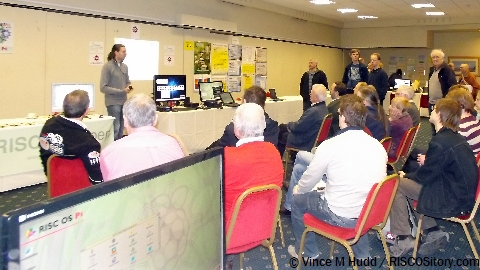
On that very subject, in fact, it’s probably worth mentioning that amongst the visitors to my stand was a chap and his son who were not RISC OS users. He had recently bought his son a Raspberry Pi for his birthday and had come along to the show out of curiosity, and both the enthusiasm and curiosity shown by his thirteen year old son was impressive, with questions galore – largely about the programming behind the software, rather than the software itself. Whether they’ll go on to try RISC OS for themselves is impossible to predict – hopefully, their visit to the show will have given them enough encouragement to do so – but the point is that just as the visitor and bandwidth graphs shown by Steve Revill are a good sign for RISC OS, indicating an increase in the level interest shown in the operating system, so too is the fact that our use (and mention) of the Raspberry Pi is drawing in visitors who have never used RISC OS before. (And, of course, the son’s fascination with how to program also shows that the thinking behind the Raspberry Pi itself is bang on the money: get the young interested in programming computers, rather than just using them, and breed a new generation of programmers.)
And back to the topic at hand, which was how much busier I had been at the show than I thought: A short while after the talk from RISC OS Open Ltd, Richard Brown of Orpheus Internet, who like last year had organised the show jointly with R-Comp’s Andrew Rawnsley, announced that Chris Evans (CJE Micro’s) was about to give “the last talk of the afternoon”.
The last talk of the afternoon? I glanced at my watch. It was just after 3:00pm, already.
Where on Earth had the day gone? This is when I knew I’d been busier than I thought!
Unfortunately, I didn’t listen to Chris’ talk – as I moved a little further back to take a photograph, I ended up chatting with another show visitor.
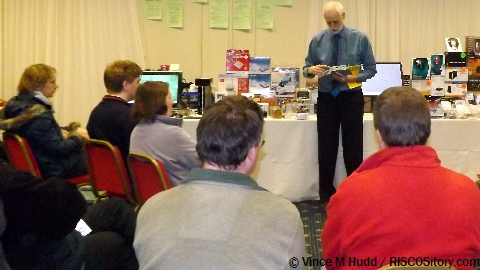
And so to the usual trip around the show exhibitors:
The first company representative any visitor would encounter at this year’s show was Richard Brown of Orpheus Internet, who this year took on the role of doorman and bouncer, manning the desk on the way into the show and taking entry fees, while at the same time keeping out any riff-raff. Or, in reality, not keeping out any riff-raff, and instead encouraging them to come in. Well, he let me in, so it must be true.
Once inside, one of the local user groups, Bristol RISC OS Users, was represented by Trevor Johnson. Trevor, who is also involved with WikiProject: RISC OS, had leaflets on his desk promoting our little user group, with details of the group’s mailing list, and the dates of the planned meetings for 2013. And this year, as an added bonus for anyone picking up a leaflet, I actually printed them with the correct postcode for the pub in which we meet! Of course, that means there’s even less excuse for local RISC OS users not to turn up; you can no longer say your sat-nav took you to the wrong pub thanks to the wrong postcode being on the leaflet. So we can expect to see lots of new members at our next meeting, on 13th March at the Hope and Anchor on Jacob’s Wells Road, can’t we?
The next stand was Archive Magazine, where Jim Nagel had a selection of back-issues for visitors to take a selection from – a variation on the offer whereby Jim will send out two sample issues to people interested in taking a subscription. As for the next issue, Jim informs me that it will be sent out soon after the show. Also available from the stand was the Volume 22 DVD-ROM or double CD-ROM, which contains all of the information published in every issue of Archive magazine from the very beginning, up to and including volume 22. (The magazine is currently part of the way through volume 23, which is why the DVD/CD-ROM versions only go up to volume 22; the next edition of the disks will be produced when the magazine moves to volume 24, meaning volume 23 is complete.)
To Jim’s left (or the visitor’s right), Christopher Dewhurst was representing another RISC OS magazine, Drag ‘n Drop, which he now edits having taken over from Paul Stewart late last year. The second issue of volume four – the second issue edited by Chris – is now available from the Drag ‘n Drop website, where a sample of the new issue can also be found. As well as promoting the latest issue, Christopher was also selling a back issues CD-ROM, containing everything from the very first issue up to and including the new issue – and given that the new issue wasn’t available from the website until a few days after the show, that means those people who purchased the back issues CD-ROM at the show got their hands on the new issue ahead of the rest of us! Christopher was also taking orders for a CD-ROM containing 55 BBC Micro and Electron programming books – not just scans packaged up as PDF files, but high quality, digitally remastered and debugged editions, with all books in a variety of formats, including Impression and EasiWriter. For those who were unable to order this disk at the show, it will be available to order in due course from the Drag ‘n Drop website.
The CJE Micro’s stand was next, fully stocked as usual, with a wide variety of merchandise to satisfy everyone’s needs. Amongst the goodies being sold by Chris Evans was a real time clock module for the Raspberry Pi. The cheapest version, at ten pounds, consisted of just the real time clock module, and, for a few quid more, there was a version with a temperature sensor. Pushing the price closer to twenty pounds, another option was a module that included power control, offering more versatile control of the Raspberry Pi’s power supply, which without it simply involves pulling the plug to switch it off.
Chris was also pushing a variety of computers based around the BeagleBoard, PandaBoard and Raspberry Pi, possibly most notably offering portable RISC OS computing in the form of the LaPi and LaPanda – a Raspberry Pi or PandaBoard based system with a LapDock solution. The LapDock is a laptop style case from Motorola, intended as a mobile phone ‘dock’ that allows certain of Motorola’s range to be used with a screen and keyboard much as a small laptop (or netbook). The model on offer from CJE offers an 11.6″ screen giving a resolution of 1366 x 768 (1360 x 768 under RISC OS) – although there is also a version of the LapdDock sporting a 10.1″ screen and one with a 14″ screen (with full size keyboard) – the LapDock 100 and 500 Pro respectively. The LapDock itself was discontinued in 2012 by Motorola due to it not being the success it had hoped for, so the solutions from CJE are very much a while stocks last (or can still be acquired).
After the CJE stand, visitors could be entertained by (or engage in) some campanology. Just as last year, John Norris had brought along his mini dumbbell for the home, a papier-mâché bell, mounted in a wooden tower for the show. The bell itself obviously doesn’t ring given what it’s made from, but it’s linked to a computer on which John’s ‘Stringing’ software is running, and it’s the computer that produces the sounds.
Doing an about turn, after John’s stand was the charity stand, through which Moss and friends were selling all manner of books, software, magazines, and so on, in support of the National Animal Welfare Trust, who have a local centre at Heaven’s Gate Farm, near Langport. The Trust gained £143.50 as a result of those who ran the stand, and those who contributed and/or bought merchandise from it.
Turning back into the main area, the next stand was home to David Snell, promoting ProCAD+ and WebWonder. ProCAD+ is, as its name suggests a CAD (Computer Aided Design) package, with a wealth of features, which can be used to produce house plans, office designs, circuit designs and wiring diagrams, and a lot more. WebWonder is an application that allows any RISC OS user to create and publish their own websites quickly and easily, with no need to understand HTML.
Next was the Organizer stand, manned by Nigel Wilmott and Martin Avison. It’s easy to think of Organizer as a replacement for Alarm, but it is so much more than that: Alarm, supplied with all RISC OS computers, provides the user with a clock and calendar/alarm system, but Organizer also provides an address book, a ‘To Do’ section, the ability to import and export data in iCal format, allowing that data to be exchanged with Google Calendar, Mozilla Sunbird, and even Microsoft Outlook.
After the show had closed, Jim Nagel and I were chatting with Martin and Nigel, and they explained that a new feature is currently being tested by selected users – a feature that would specifically address one of Jim’s needs; the ability to use the same data on several networked machines. The approach adopted by Martin is that of a master and clone(s), whereby one machine contains the primary, master installation, and any other machines run the clone installation; when started, the clones will interrogate the network to find the master, and copy (or clone) the Organizer data to itself so that the machine at which the user is working has any contact information that will be needed, and will sound any alarms, etc. The downside of this, a point I specifically raised with Martin, is the need to use the master machine to add any new alarms, etc., rather than do so from the machine actually in use – an approach a more customary server/client model might have offered – but Martin explained he chose this route as a method of ensuring data integrity; preventing any mishaps if the clone (or client using the other model) tried updating the master (server) and it had become unavailable, especially if that happened mid-update. I have to be honest and say I’m not entirely convinced; I’m sure there are ways to work around and prevent such problems – I can think of a few – but the bottom line is that, to state the obvious, Martin knows his software better than I do, so I can’t say what would and wouldn’t work for Organizer (and its users).
Next to Nigel and Martin was yours truly, wearing my Soft Rock Software hat top, and I was, as usual, making excuses for not having finished the WebChange manual – although this time I did have a shiny new excuse, having been given strict orders from the doctor to slow down, do less and relax more. However, I was also explaining that progress has been made on the manual, but in a way that has actually created more work for me and thus counters my doctor’s orders; as I’ve worked on the manual, I’ve changed some aspects of it and created a need for a separate tutorial manual (and the associated files for that) and even written into the manual some features of WebChange that don’t actually exist, so need to be added. Oops!
Visitors to my stand could also see fellow Bristol RISC OS User Chris Hall’s Raspberry Pi running RISC OS attached to a four inch (I think) screen, and all powered by a set of four AA batteries. Unfortunately, a fault developed with it that caused the screen to flash on and off frequently, and later just remain blank once it had booted, but boot it would do and, before the fault developed, it was a simple matter of plugging my keyboard and mouse into it to use it.
To my left, Steve Fryatt was exhibiting his software, including a completely new version of Locate. Cunningly titled Locate 2, it was made available for testing a week or so before the South West Show took place. Steve explained that the BASIC and ARM code of the original has become increasingly unmaintainable, so a complete rewrite was the only sensible way to go. Being a test version, Locate 2 does lack some features, but it is also much improved and might also be faster than the older version of Locate, and multitask in a “less anti-social way”.
The next stand was RISC OS Open Ltd, where Steve Revill and Ben Avison were on hand to answer any questions about the shared source RISC OS, where it’s been, where it’s going, will it send any postcards, and so on. The boys were also selling RISC OS Pi and Nut Pi SD cards – the former being an SD card from which RISC OS can be booted on a Raspberry Pi, and the latter containing a selection of RISC OS software that can be used on the board.
I purchased Nut Pi for the second time, having originally done so at the London Show; I had to wait for that one to come in the post, but when it arrived I immediately put it “safe and sound” in my desk drawer to be installed “later” – later came the day before the South West show, when I discovered that far from being safe and sound, the card was missing. Steve joked that I may have purchased one of ROOL’s special “dissolving” SD cards. Hmm!
Having bought it again, this time I put it straight in my Raspberry Pi at the show and copied it over to the card on which RISC OS is installed. The software itself, I’ll install “later” – but at least this time it’s on the card that’s in the machine, so it’s definitely not going anywhere!
On the upside, at least I didn’t get home from the show and immediately find the original. That would have been even more annoying than losing it in the first place.
The ROOL stand was also home to a camera that was taking photographs of the hall every 25 seconds – and using those photographs, they’ve condensed the entire show into a one minute sixteen second video:
The next stand revealed something very unexpected – and apparently it was only agreed upon at the very last minute. That stand was ROUGOL‘s – the RISC OS User Group of London – and they had Impression X running under Aemulor on a PandaBoard. What’s so unexpected about that? Well, nothing, really – none of the Impression family have been updated to 32-bit compatibility, so the only way to run any version of it on an Iyonix or anything more recent is via Aemulor.
It’s the reason it was running that was unexpected.
It is now some ten years since X-Ample Technology acquired the source code to Impression and began the process of 32-bitting it, with the new version to be called Impression X, but that process had seemingly stalled, with no news having emerged for some time. The “Info” box of the version running at the show contained an “Author” field that declared it copyright “1986 – 1996 CC Ltd” and “2003 X-Ample bv” – but it also declared it copyright “2013 Richard Keefe”, and the version box described it as version “5.726 Dev (23-Feb-2013)”.
It emerged that Richard (a member of ROUGOL) is now going to be working on the software, though completion is a very long way off – in a comment during the RISC OS Open talk, Richard estimated that there was probably 2,000 man-hours of work to do which, even if he was working full-time on the task, could mean the better part of a year. The reality, though, is that he’s going to be doing the work in his spare time, so it’s going to take considerably longer than that.
ROUGOL members also pointed out to me several times during the day that the date for the 2013 RISC OS London Show has been set; it will take place on 26th October, 2013, at the usual venue – the St Giles Hotel, Feltham.
The MW Software stand was next, where visitors could discuss and purchase the latest versions of EasiWriter, ArtWorks 2, and so on. I didn’t speak to Martin at all this time around, and from previous conversations I know he’s unlikely to have had any new versions available, because he tends to time things so that new versions are released for Wakefield and London. Martin does have a new trademark that he has developed over the last few years, though – booking a large amount of space, and then only occupying a small part of it. This, he explained to me some time ago, is simply because he has a lot of posters to put up at shows – it is these for which he requires the width.
And the final stand was occupied by R-Comp, who brought along their usual array of computers, some running RISC OS under emulation, and some running it natively – the ARMini and ARMiniX. As usual, R-Comp also launched new versions of some of their software at the show.
MusicMan 2, their offering for “ripping” and managing music collections, saw an update that makes it easier to add cover artwork. It already included a mechanism to add album cover artwork, but this has been extended to include an internet look-up. This feature doesn’t use the standard freedb internet service which it uses to identify CDs and their track listings, since that doesn’t include the artwork. Instead, the software will “search online services” for suitable images – and it can look up individual tracks, either as an ordinary search (“perhaps for lyrics”, Andrew mentioned – in which case, might I suggest investigating the various lyric servers that exist on the internet for use in a future version?) or seeking images, allowing artwork to be added that’s appropriate to the track, rather than the CD – useful if it’s a compilation.
R-Comp also had an updated version of Messenger Pro. Version 7.05 includes built-in POP/SMTP facilities, making the application an easier to install and set-up “complete” email solution. As RISC OS users, we are accustomed to – and, let’s be honest, welcome – the idea of having separate applications talking to one another for separate, but related, tasks; so we are used to having one application to read email, but a separate application to transfer that email to and from the remote servers. It is common on other platforms, however, for the email software to carry out those transfers for itself – and this update to Messenger Pro means it can now work in that way.
Moving from software to hardware, R-Comp had also brought along a new version of their tablet computer. The “2013 edition” of the R-Comp Tablet is powered by a dual core Cortex-A9 running at 1.6Ghz, and comes with Android version 4.1 (aka Jellybean), 16Gb of memory, an IPS display with a higher screen resolution (and an Android-standard 16:10 screen ratio), and Bluetooth connectivity.
Raspberry Pi users were catered for by R-Comp as well, with the launch of their PiPlus support scheme – a variation on the support schemes they already provide for BeagleBoard and PandaBoard users. As well as the usual benefits of the support scheme – a dedicated download site, custom software, discounts, advice, mailing list access, etc. – members will receive a high performance 16GB SD card, providing them with a main drive that can hold RISC OS itself and leave plenty of space for applications and data, with roughly 1GB supplied initially.
Anyone at the show late in the day will also have noticed a small gathering in one corner. This was the Midlands User Group, who decided to hold a meeting at the show – to discuss, no doubt, the Midlands Midsummer MUG Show, which they were discussing with exhibitors during the day, and which is scheduled for July 13th, 2013, at the usual venue – at St John’s Church Hall, in Kenilworth.
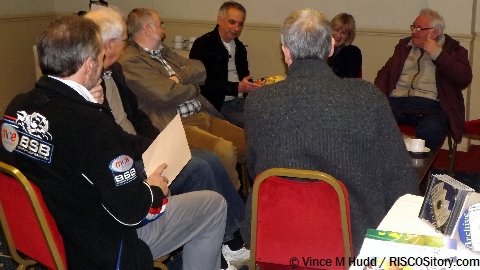
And that was RISC OS South West, 2013!
Update:
It seems that if I’d had time to actually talk to exhibitors this year, John Norris would have been someone well worth chatting to. This year, John’s bell ringing software, Stringing, was running on a Raspberry Pi. And while that might not sound like a hugely interesting thing – an increasing number of exhibitors are using the tiny computer, after all, and Stringing itself is written in BASIC, so it’s no real surprise that it would work – what would have made it an interesting chat would have been the case in which it was housed. In the run up to the show, John had spent a good few hours building the Pi into a reasonable looking case, which was christened “Pi in a Box” by somebody at the show. John kindly sent me a photograph of his creation, which I’m sure he won’t mind me reproducing here:
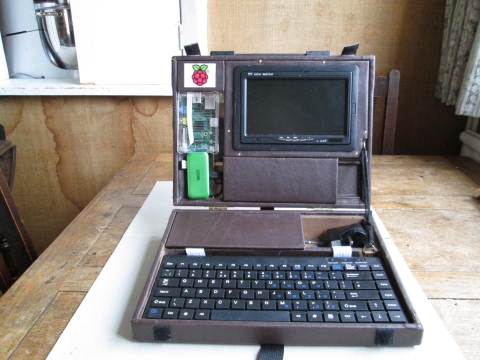
John modestly informs me that “there’s no need to make much of it” (and says he’ll happily provide brief details and photos if anyone wishes to copy the design – contact details can be found on his website) – but I think it deserves to be highlighted. I think that this should probably have featured in the Raspberry Jam section, in the centre of the room – which would have made John’s mini dumbbell something of a centrepiece at the show.
Speaking of the Raspberry Jam section, this is something I completely forgot about in the show report – even though I did actually speak to Steve Drain, who I believe was the only exhibitor in that section. Steve, more well known for Basalt, his module for providing BASIC with additional (Alternative) keywords, had once again brought along his Lapdock/Raspberry Pi combos – only this time, with a very neatly cased Raspberry Pi. The case Steve showed me was a little wider and a little taller than my phone (a Samsung Galaxy SIII) – and not much deeper. In other words, it was quite a flat case, which means some modifications had to be made to the Pi itself to fit it in – but having done so, when attached to a Lapdock, it looks a lot tidier than having a normal Raspberry Pi attached. Steve has published pictures and some details of his modified Pi and the case – which he has dubbed the Raspberry Pip – on his website.
And that was definitely RISC OS South West, 2013!



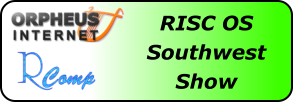
Thanks for a very interesting and thorough report, Vince.